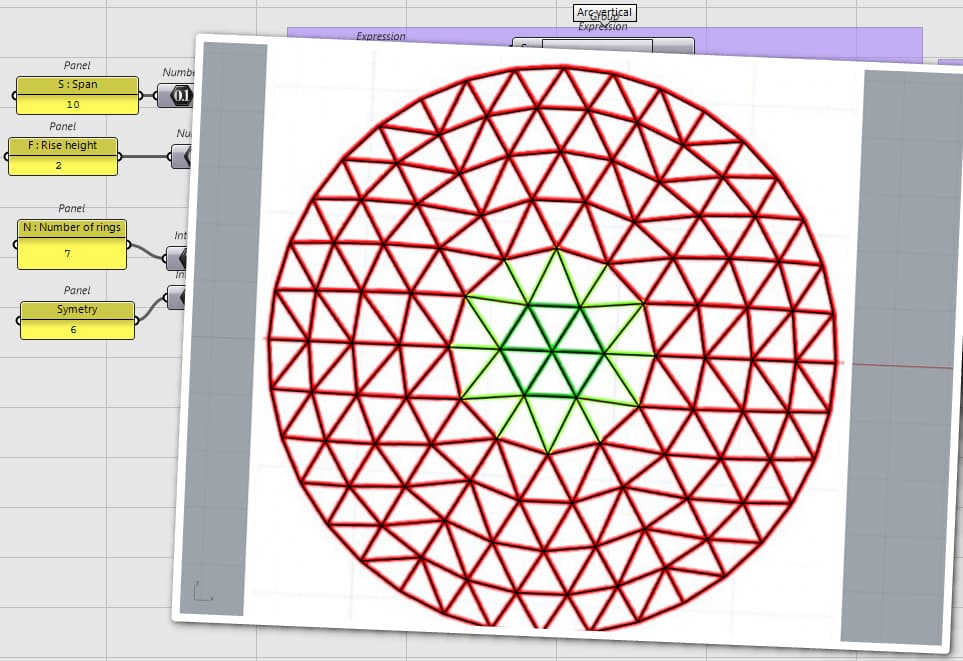Hey dear community,
Does anyone have experience with constructing a Diamatic dome ?
I can find plenty of information on Geodesic domes and other auto-generated plugin options, but I would like to know if there is something more accurate out there.

This is an example, the triangles should be equilateral according to their colour coding.
Thanks in advance!
They sure don’t look like equilateral triangles to me?

By construction you mean
Make a 3d model with lines
Make a 3d model for real live construction
Make a real one with matches
…
if you are interested in first it doesn’t seem too difficult to do
I understand there are 6 identical parts
On top triangles could be equilateral but it means the top is flat and it doesn’t seem a good idea.
Then all ring row are on a plane and ends are on a circle.
With some basic geometry,
calculate the angles
Finite Element Analysis of Diamatic, Schwedler and Diamatic-Schwedler Hybrid Domes
Amjatha Makkar#1 , Sumayya Abbas#2 , Muhammed Haslin S.M#3
#1PG Student, Department of civil Engineering, JBCMET, Ernakulam, Kerala, India
#2Assistant Professor, Department of civil Engineering, JBCMET, Ernakulam, Kerala, India
#3Structural Engineer, 3610 Architects, Perumbavoor, Ernakulam, Kerala, India
Make the arc
Make the points
Link the points
Polar array the whole
diamatic dome.gh (25.2 KB)
2 Likes
At first I was working the entire dome but the data trees got so complicated that I focused on just 1/6th section. It wasn’t too difficult to get the unique line segments and I could easily rotate this to make the five other sections but… I haven’t been able to figure out how to make triangular panels?
1 Like
Delaunay is working as long as Span/Rize > 2
Ball pivot seem to work a bit better,
And Convex Hull also but you get a closed volume
1 Like
I had tried Delaunay Mesh but saw extra edges that I don’t want:
I don’t have parametric control of the “Span/Rise” ratio. Not even sure what it is?
Ball Pivot? Never heard of that and I don’t seem to have it.
I had also tried.Convex Hull but it fails badly on the 1/6th section I’m working on.
Rise is the height and Span the diameter.
Span is S
Rise is F

I don’t really use often Ball Pivot but this tool must be from David Reeves
And now it could surely be replaced by Point cloud tool from CoackRoach.
Ah, so. You know how I am with plugins - old habit from early days of programming, a long time ago…
I got it! Sort of… as long as my count slider doesn’t go above 7.  This is a hemisphere.
This is a hemisphere.
Diamatic Dome_2022_Nov9a.gh (49.8 KB)
1 Like
Finally, I really got it. Flat triangular panels. no limit on divisions (‘Count’ slider in purple group).
Diamatic Dome_2022_Nov9c.gh (63.2 KB)
Way better! 
P.S. Some stats with ‘Count’ slider set to 5 and sphere radius set to 10:
-
Each 1/6th section has 25 unique faces (times 6) for a total of.150 faces in the hemisphere.
-
Rounded to three decimal places and not counting angles, there are 15 sizes in area (3.262 To 5.412) and perimeter length (8.673 To 10.747).
4 Likes
@Joseph_Oster @laurent_delrieu
Thank you both so much! I have no idea why I got fixated on having equilateral triangles and then got completely mentally blocked from there. That’s was a misinterpretation from my side. Thank you again very much for your help.
Hi. I need help. Should the pattern on this dome be a rhombus shape of the same size? What I found on the internet: “the circular plan is divided into several sectors (usually six or eight), and each sector is subdivided by parallel ribs into rhombus grids of the same size. This type of lamella dome is very popular in the United States. It is sometimes called a Kiewitt dome”
I can’t get it. I drew the arc divided it by 6, and linked the points and I have rhombus shapes of all sizes. The green pages are 242,270,244 and 265. The red one is a bit more similar but still all different.
How do I construct it in AutoCAD? I don’t know what I’m doing wrong.






















